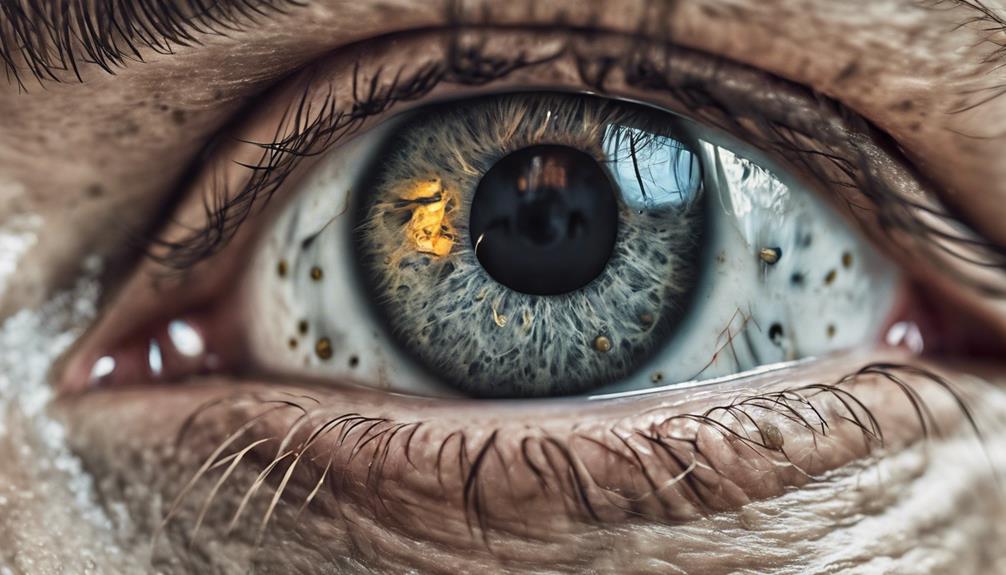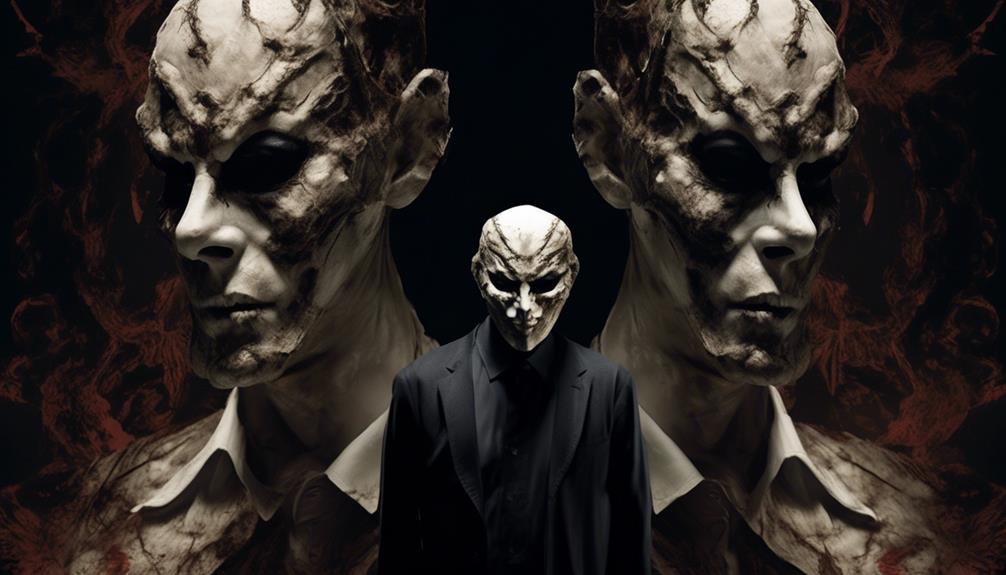By shining a light on the intricate world of narcissistic traits, we uncover the unsettling truth lurking behind the mesmerizing gaze of individuals displaying such characteristics.
The eyes of a narcissist can be likened to a spider’s web, drawing you in while ensnaring you in their manipulative grasp.
Curious to understand how this gaze holds such power over others? Stay tuned as we dissect the nuances of the Narcissist Stare, revealing the unsettling tactics behind their predatory eyes and equipping ourselves with the tools needed to navigate these calculated maneuvers.
Key Takeaways
- The Narcissist Stare is a tool for manipulation and intimidation.
- Eye contact triggers bonding chemicals, fostering false intimacy.
- Recognize different forms of the stare to identify manipulation tactics.
- Understanding the stare is crucial in recognizing narcissistic behavior.
The Power of the Narcissist Stare
How does the Narcissist Stare exert its manipulative influence on individuals subjected to it?
The Narcissist Stare, with its cold and penetrating gaze, serves as a potent tool for manipulation and intimidation. When directed towards a victim, it can evoke feelings of discomfort, vulnerability, and unease.
Through prolonged eye contact, narcissists aim to assert dominance, probe for weaknesses, and instill fear in their targets. This predatory stare is a calculated strategy used to maintain control and power over others.
Unmasking the Manipulative Gaze

Unveiling the manipulative gaze employed by narcissists reveals a calculated strategy to assert dominance and instill fear in their targets through prolonged eye contact. This intense gaze is designed to unsettle and intimidate, leaving the recipient feeling vulnerable and uncomfortable.
By maintaining prolonged eye contact, narcissists aim to learn about their victims, mirroring behaviors to gain control and establish dominance. The predatory stare, with its cold and menacing quality, is a powerful tool used to keep targets off balance and instill fear.
Recognizing this manipulative tactic is key to protecting oneself and understanding the dynamics at play. Awareness of the intentions behind the stare can empower individuals to respond effectively and seek support when necessary.
Understanding Narcissistic Eye Contact
The manipulation tactics of narcissists extend beyond the physical gaze, encompassing the intricate dynamics of narcissistic eye contact. Understanding narcissistic eye contact is crucial in recognizing the depth of manipulation and control exerted by these individuals.
Through eye contact, narcissists aim to assert dominance, instill fear, and create a false sense of intimacy. Prolonged stares are used to unsettle and learn about their victims, enabling them to tailor their manipulation strategies effectively.
The menacing cold stare and predatory gaze are tools wielded to intimidate and maintain control over others. Recognizing the purpose behind the narcissistic eye contact is the first step in safeguarding oneself against the harmful effects of their manipulative tactics.
Impact of the Stare on Victims

The Narcissist Stare exerts a profound psychological impact on its victims, leaving them vulnerable and psychologically manipulated.
When subjected to this intense gaze, individuals often experience a sense of unease and discomfort, as if their innermost thoughts and vulnerabilities are being laid bare.
This stare can evoke feelings of inadequacy, fear, and self-doubt, leading to a loss of confidence and autonomy. Victims may find themselves questioning their own perceptions and reality, falling prey to the narcissist’s manipulative tactics.
The lasting effects of this stare can linger, affecting one’s sense of self-worth and ability to trust others. Recognizing the detrimental impact of the stare is crucial in safeguarding one’s mental and emotional well-being.
Recognizing Manipulation Tactics
Identifying subtle cues and patterns in behavior can aid in uncovering manipulation tactics employed by narcissists. By paying close attention to non-verbal cues like prolonged eye contact, intense gazes, and attempts to make the victim feel vulnerable, one can start to recognize the signs of manipulation.
Narcissists often use a menacing cold stare to intimidate and maintain control, creating a sense of unease in their victims. Understanding these tactics can empower individuals to protect themselves from falling prey to narcissistic behavior. It’s essential to trust instincts when feeling fear induced by a stare and seek support if necessary.
Recognizing manipulation tactics early on can help prevent further harm and allow for appropriate action to be taken.
Dealing With Intimidation Through Eyes

Recognizing and addressing intimidation tactics through eye contact requires a keen understanding of non-verbal communication cues and assertive responses. Dealing with intimidation through eyes involves maintaining composure, setting boundaries, and responding confidently. Here is a table illustrating effective strategies:
| Strategy | Description | Benefits |
|---|---|---|
| Maintain Eye Contact | Demonstrate confidence and show assertiveness | Establish control and convey strength |
| Set Clear Boundaries | Communicate limits and prevent manipulation | Assert personal space and autonomy |
| Respond Assertively | Address intimidation directly and assert boundaries | Assert control and deter further intimidation |
Insights on Narcissistic Behavior

Delving into narcissistic behavior provides valuable insights into the complex dynamics of manipulative individuals. Understanding the behaviors associated with narcissism can aid in identifying and potentially protecting oneself from such individuals.
By recognizing patterns of manipulation, intimidation, and control, one can develop strategies to navigate interactions with narcissists more effectively. Insight into how narcissists use tactics like prolonged eye contact and the predatory stare can empower individuals to set boundaries and protect their emotional well-being.
Awareness of narcissistic behavior can also help in recognizing red flags early on in relationships or interactions, providing an opportunity to address or avoid potentially harmful situations. Educating oneself on narcissistic behavior is a proactive step towards safeguarding against manipulation and fostering healthier relationships.
Responding to the Predatory Stare

Understanding the predatory stare’s impact on emotional well-being is crucial for effectively navigating interactions with manipulative individuals. Recognizing the predatory gaze allows us to respond with awareness and protection. When faced with the manipulative stare, maintaining boundaries and staying grounded in our own truth is essential. Trusting our instincts and setting clear limits can help deter narcissistic manipulation.
Seeking support from trusted individuals or professionals can provide guidance on handling such encounters. Remember, self-care and self-respect are paramount when confronting the predatory stare. By staying mindful of our emotional well-being and responding assertively, we can safeguard ourselves from the effects of narcissistic manipulation.
Frequently Asked Questions
Can the Narcissist Stare Be Used by Individuals Who Are Not Diagnosed as Narcissists?
Yes, the narcissist stare can be utilized by individuals not diagnosed as narcissists. This gaze may manifest in those seeking control or manipulating others. Understanding the intent behind prolonged eye contact is essential in recognizing potential manipulation tactics.
Awareness of these behaviors can empower individuals to identify and respond effectively to such intimidating and unsettling stares. Trusting instincts and seeking support when feeling vulnerable are key in navigating such encounters.
How Does the Narcissist Stare Differ From a Regular Intense Gaze or Eye Contact?
When comparing the narcissist stare to regular intense eye contact, the difference lies in the intent and effect.
The narcissist stare, with its cold, penetrating gaze, seeks to manipulate and intimidate by preying on vulnerabilities. In contrast, a regular intense gaze may convey sincerity or interest without the underlying malice.
Understanding these distinctions can empower us to discern manipulative behavior and protect ourselves from potential harm.
Are There Any Specific Body Language Cues That Accompany the Narcissist Stare?
When encountering the Narcissist Stare, we notice specific body language cues that accompany this manipulative gaze. These cues include a cold, blank expression, intense eye contact that feels invasive, and a predatory presence that can be unsettling.
The body may also exhibit signs of tension, rigidity, or an imposing stance. Understanding these subtle yet powerful nonverbal signals is crucial in recognizing and responding to the narcissist’s manipulative tactics.
Is There a Way to Effectively Counter or Deflect the Effects of the Narcissist Stare?
Facing the Narcissist Stare, we find power in redirecting our focus and maintaining inner strength. By grounding ourselves in self-assurance and setting clear boundaries, we can deflect the impact of their gaze.
Refusing to engage in their manipulative tactics diminishes their control. Our resilience is a shield against their attempts to unsettle us. Embrace your autonomy and refuse to let their stare penetrate your confidence.
Can the Narcissist Stare Be a Learned Behavior, or Is It Primarily Innate in Narcissistic Individuals?
We believe that the narcissist stare can be a combination of both learned behavior and innate traits in narcissistic individuals.
While some aspects of the stare may be ingrained in their personality, the manipulative and intimidating elements could be honed over time through experience and observation.
Understanding this duality can aid in developing strategies to counter or deflect its effects effectively.
Conclusion
In conclusion, the Narcissist Stare serves as a chilling window into the manipulative tactics of individuals with narcissistic tendencies. It’s a predatory gaze that can intimidate, control, and instill fear in its victims.
By recognizing the subtle yet potent influence of this gaze, we empower ourselves to protect against manipulation and respond effectively to these calculated maneuvers.
Let’s not be ensnared by the captivating yet dangerous eyes of the narcissist, but instead, see through their facade with clarity and strength.
Our Content Strategist, Jordan, has a knack for deciphering the digital landscape to determine what our audience seeks. With a foundation in behavioral science and digital marketing, Jordan crafts our content strategy, ensuring that our topics are relevant, research-based, and resonant. Their strategic approach helps Narcissistic Man reach hearts and minds across the globe.











